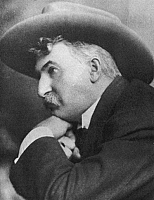Don Maguire: Utah Catholic adventurer

Utah history can hardly boast a more colorful character than Don Maguire, a trader, traveler, miner, archaeologist, poet and public figure who was one of the original members of Saint Joseph Parish in Ogden and lived in that city for more than six decades. Unfortunately, separating fact from fiction in telling the story of his life is no small problem, for most biographical information comes from his own pen, and he was known to stretch the truth. But even if only part of his narrative is true, he ranks with some of the legendary figures in Western history. The youngest of several children, Dominic Maguire (he never used his full given name) was born in Vermont in 1852 to Irish immigrants. His father, John, was an Irish separatist reputedly with a price on his head in Britain. After making a small fortune in livestock and land speculation in Iowa, John brought his family to Ogden, hoping to use that railroad hub as a supply center for an itinerant trading business on the western frontier. On Jan. 5, 1872, Fr. Patrick Walsh from Salt Lake City celebrated the first Mass in Ogden at the home of Don’s brother Michael, and the Maguires continued to be mainstays of Ogden Catholicism. Don developed a linguistic facility while attending a Franciscan college in California and used his competence in French, Spanish and Arabic to great effect on trading expeditions to Montana, Mexico, and even North Africa. Although he made unnumbered trading trips to Idaho, Montana, and the Uintah Basin, he is best known for three well-documented trips from Ogden through the mining camps and Indian villages of Nevada, California, Arizona, and as far south as Mexico. Maguire’s trips were only possible during a narrow span of frontier history, for they bridged the gap between the expanding western railroad networks and the outlying settlements that were still beyond their reach. It was financially and personally very risky, for the Indians he dealt with vastly outnumbered his crew and were inconsistently friendly, and the mining camps were infamous for their populations of desperadoes eager for easy money. But Maguire and his crew, which typically numbered only three or so, were well armed and shrewdly diplomatic, and the expeditions proved to be extremely profitable. The first expedition, in 1876, consisted of Maguire and two crew members, with three saddle horses and 14 mules. Because he was unaware of the terrain he would encounter in southern Utah, Nevada and Arizona, pack animals were the obvious choice despite their limited payload and the necessity of loading and unloading them every morning and evening. Thereafter, on his trips in 1877 and 1879, he had worked out routes that allowed the use of wagons. Western trade, as indeed most business in the late 19th century, was almost totally unregulated, and Maguire on one trip sold obsolete army muskets, which would probably have been branded contraband at a later period. Some of them he traded to a large band of Indians in Arizona, then pulled out with muffled wagon wheels in the middle of the night while the Indians slept, and then unloaded the rest to a Mexican smuggler who found them "useful for revolutionary and other social purposes." (Maguire, in fact, was capable of some very witty expressions: commenting on the vile wine manufactured in St. George, he reported that "so rascally is the nature of this drink that people of Arizona and Nevada claim that a man who drinks a quart of it will get up in the night and steal his own clothes.") His trading days over, Maguire joined his family in Ogden and spent the rest of his life in mining speculation and archaeology, conducting excavations in Paragonah, Capitol Reef and Grand Gulch. He became a pillar of the community and church. His death came tragically on the night of Jan. 7, 1933 when he was struck by a car as he was crossing a street while returning home from confession at St. Joseph Church. Other than martyrdom, no Catholic could have planned a better exit.
© Copyright 2024 The Diocese of Salt Lake City. All rights reserved.

Stay Connected With Us